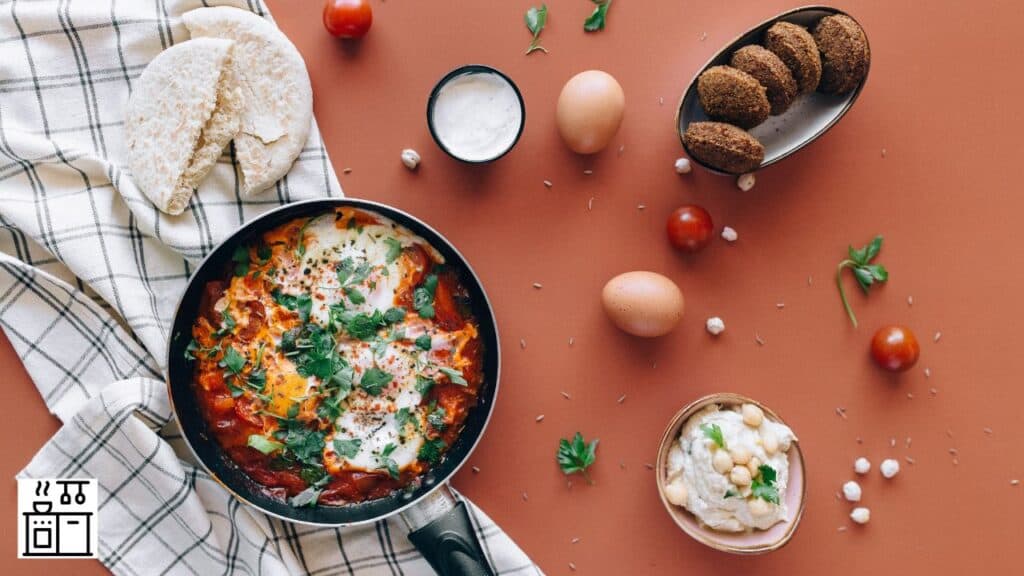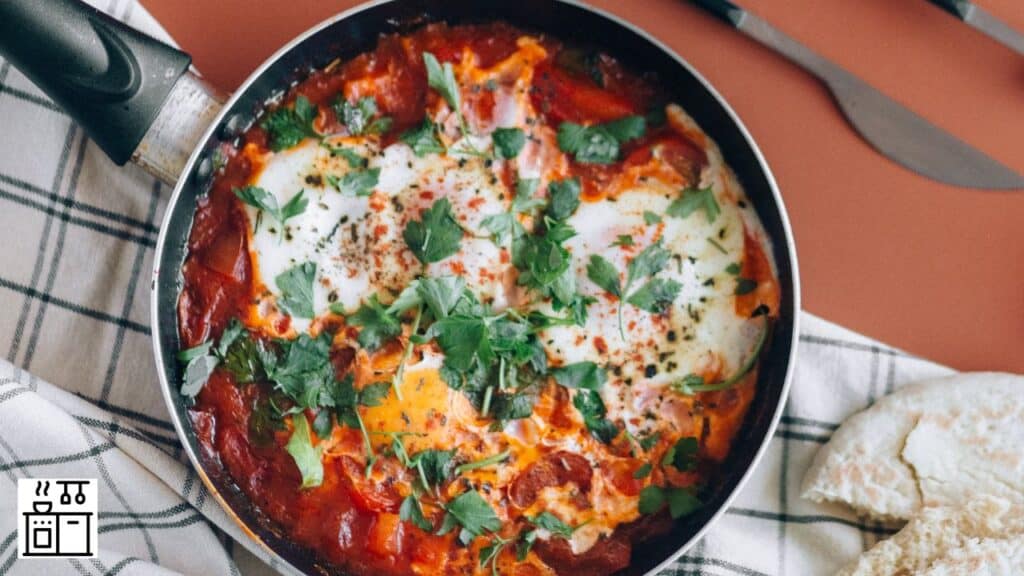Ceramic cookware is very popular as an alternative to Teflon pans.
Most ceramic pans are technically not 100% ceramic, but they have a metal base sandwiched between layers of ceramic coating.
This coating contains sand-derived silicon. Like all types of cookware, ceramic pans also have their pros and cons.
Let’s find out what they are.
Pros of Ceramic Pans
Here are the advantages and attractive features of ceramic pans.
1. Non-Stick Coating
Ceramic pans have a unique non-stick property that is different from other types of cookware.
Their smooth and slick surface arises from the presence of a sol-gel layer.
This layer releases silicone oil each time the pan is heated. It makes the surface non-sticky and helps food to glide across it.
So you will not need much oil or butter to cook food in a ceramic pan.
2. Non-Toxic Cooking Surface
Ceramic pans are considered a healthier alternative to Teflon pans. Their ceramic coating isn’t toxic like the PTFE coating in Teflon pans.
Older Teflon pans would release toxic fumes when the coating eroded and you heated it.
Though modern Teflon pans are not as vulnerable, consumers still hesitate to use them because of this history.
The surface layer of ceramic pans is stable and heat-resistant. So overheating doesn’t cause any damage or produce toxic fumes.
Further Reading: Ceramic Pans vs. Teflon Pans (7 Main Differences)
3. Lightweight
One of the main benefits of using ceramic pans for daily cooking is the ease of cleaning. Their non-stick surface prevents food from sticking.
You can easily clean the surface with warm soapy water and a gentle sponge or scrubber.
Even if you burn food in this pan, soaking it in hot water will help to get rid of the burnt residue.
Nevertheless, handwashing is generally recommended for these pans.
4. No Need for Seasoning
Cast iron and carbon steel pans are close contenders for ceramic pans because they are also non-stick.
However, you must initially season these pans to create a patina that produces their non-stick properties.
Additionally, these pans require regular seasoning to maintain their non-stick capabilities.
Ceramic pans don’t present such conditions. You do not have to season them even once to enjoy their non-stick properties.
The pans will naturally release food from the surface even if you are using them for the first time.
5. Easy to Handle
When we compare ceramic pans with carbon steel and cast-iron pans, they are much easier to handle. These pans are not too heavy.
You can easily pick them up and move them around. It makes transferring from the stovetop to the table or oven much easier.
They are also easy to handle and lift even when hot.
6. Heat Distribution
Ceramic pans have excellent heat distribution properties. You can use them for cooking without worrying about the formation of hot spots.
The pans will also retain heat for a long time. So the food remains warm in these pans.
The heavy and layered base of these pans also allows for even cooking. The pan surface is sturdy and not prone to warping.
7. Durability
With proper care and maintenance, ceramic pans enjoy a long lifespan.
The layer of sol-gel releases silicone oil for a long time, making the pan retain its non-stick properties.
Even when this layer degrades, you can use oil or butter to keep using the pan.
Ceramic pans typically last longer than Teflon or Aluminum pans. They usually last as long as stainless-steel pans with proper care.
8. Attractive Colors and Designs
Ceramic pans are some of the most attractive pans you will find in the market.
They are available in an array of colors and look very beautiful. The contrast of their iconic colors with a white or light base makes them stand out.
These pans are prized by designers and decorators because of the pop of color and sophistication they add to a kitchen.
The added advantage is that they are just as functional as they are beautiful.
Cons of Ceramic Pans
Let’s now look at the problems associated with ceramic pans.

1. Lifespan of The Ceramic Coating
Ceramic pans last longer than their Teflon counterparts. But they don’t last as long as cast iron or carbon steel pans.
The ceramic coating deteriorates with continuous use, and it loses its non-stick properties over time.
Exposure to high heat and rough handling makes it wear off faster. High-quality ceramic pans last longer, but they are very expensive.
2. Cleaning
Ceramic pans are not as delicate as Teflon pans. Their surface coating doesn’t wear off easily.
Nevertheless, you should handle them carefully. They are vulnerable to rough and abrasive cleaners.
Using such cleaners on their surface will affect the coating and damage them quickly.
For this reason, it’s not advisable to put them in dishwashers too.
Rough and hot dishwasher cycles can make their surface coating deteriorate faster. It will reduce their lifespan.
Handwashing is the best way to extend the life of these pans. But it may not be as convenient as dishwashing the pan.
Further Reading: How to Clean Ceramic Pans? [5 Different Ways]
3. Unsuitable for All Cooktops
Ceramic pans work well on the stovetop. Some of them can also go in the oven. Check the manufacturer’s instructions to be sure.
However, ceramic pans are unsuitable for induction cooking unless specified by the manufacturer.
Induction cooking is possible only with cookware made of ferromagnetic materials. Ceramic pans seldom meet this requirement.
4. Develop Stains and Discoloration
Ceramic pans are very attractive because of their iconic colors and beautiful white or light-colored surfaces.
However, the same things present unique problems too.
Ceramic pans can develop stains from ingredients like tomatoes or beets.
If you leave food cooked containing these ingredients in the pan for a long time, the stains can set in.
Not only do they become difficult to remove but they also alter the appearance of the pan.
Continuously using these pans to cook such ingredients can make them ugly.
5. Price
Ceramic pans are very expensive compared to pans made from other materials.
Most brands sell them at a premium price, making them a very high investment.
Though they are very useful and usually last for years, this factor makes them less attractive.
6. Lack of Safety Studies
Ceramic pans are generally safer than Teflon-based non-stick pans. However, there is limited safety information about ceramic pan surfaces.
Not many studies are available on the safety aspects of the sol-gel layer in ceramic pans.
So we don’t exactly know if there is any danger associated with ingesting traces of silicone oil with food.
It’s also possible that the porcelain glaze on some ceramic pans contains lead.
So it’s essential to check the manufacturing details thoroughly before buying a ceramic pan.
Summary of The Pros and Cons of Ceramic Pans
| Pros of Ceramic Pans | Cons of Ceramic Pans |
|---|---|
| Non-stick coating. | Doesn’t last as long as cast iron, stainless steel, or carbon steel pans. |
| Non-toxic cooking surface. | Not dishwasher-friendly. Handwashing recommended. |
| Lightweight and easy to handle. | Unsuitable for induction cooktops and very high-heat cooking. |
| No need for seasoning. | Stains and discolorations occur when used to cook or store certain ingredients. |
| Easy to handle. | Expensive. |
| Good heat distribution. | Lack of safety studies regarding the sol-gel surface. |
| Durable. | |
| Available in attractive colors and designs. |

